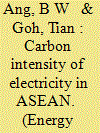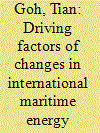|
|
|
Sort Order |
|
|
|
Items / Page
|
|
|
|
|
|
|
| Srl | Item |
| 1 |
ID:
149885


|
|
|
|
|
| Summary/Abstract |
The Association of Southeast Asian Nations (ASEAN), with its ten member countries, has a total population exceeding 600 million. Its energy-related CO2 emissions have been growing and in 2013 amounted to 3.6% of total global emissions. About 40% of ASEAN's energy-related CO2 emissions are currently attributable to electricity production. In view of this high share, we study the CO2 emissions of ASEAN's electricity production sector with a focus on the aggregate emission intensity (ACI) given by the level of CO2 emissions for each unit of electricity produced. Drivers of ACI are analysed for individual countries and spatial analysis is conducted by comparing factors contributing to differences between the ACIs of individual countries and that of the ASEAN average. Arising from these analyses and in light of the current developments, it is concluded that drastic actions need to be taken both at the national and regional levels in order to reduce growth in the region's electricity-related CO2 emissions. Two key policy issues, namely overcoming national circumstances to improve electricity generation mix and improving power generation efficiency, are further discussed.
|
|
|
|
|
|
|
|
|
|
|
|
|
|
|
|
| 2 |
ID:
180106


|
|
|
|
|
| Summary/Abstract |
Emissions have been a critical concern for the shipping sector, calling for climate mitigation measures to be implemented in this field urgently. It is therefore useful to understand the factors that influence the relevant empirical trends so that policies can be better tailored to address the climate challenges. Given the high reliance on fossil fuels, this paper has focused on the energy consumption from international shipping, by examining 6 factors across product types and shipping routes. This is based on comprehensive microdata of almost all vessels in the world over 2014–2017. The study finds that improvements in energy intensity is consistent across product types and shipping routes, reinforcing the importance of energy efficiency as a key climate mitigation measure. However, shifts in freight transport activity across different regions have offset gains in energy efficiency and was the most dominant factor contributing to an increase in energy consumption. Monitoring of the transport structure effect is critical for progress tracking and the potential of this effect to alter energy consumption should also be factored into emission projections.
|
|
|
|
|
|
|
|
|
|
|
|
|
|
|
|
| 3 |
ID:
175256


|
|
|
|
|
| Summary/Abstract |
Energy efficiency is one of the key goals in energy and climate policies. However, it is known to be difficult to define and measure. In the literature, there are many debates on the appropriate way to measure energy efficiency performance for policy development. There is also a fair share of confusion over how different energy efficiency performance estimates should be interpreted. We discuss the sources of contention by examining different definitions, methods, measures and policy objectives that are used to evaluate energy efficiency. The objective is to present the different results and purposes in a systematic manner within the broader end goal of improving national energy efficiency. A clearer picture of the underlying assumptions, boundaries and perspectives behind energy efficiency performance is important for policy assessment. With this larger goal in mind, we conclude that policymakers are free to choose any definition, method and measure for analysis. However, results should be interpreted with respect to the method, assumptions, limitations and context that they were developed for. Specifically, differences in results at different levels of analysis should be studied in detail to understand the challenges faced in translating efficiency improvements at the device, process and sub-sector levels to national level improvements.
|
|
|
|
|
|
|
|
|
|
|
|
|
|
|
|
|
|
|
|
|